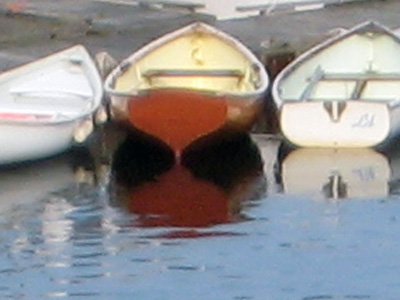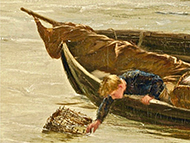THE FOX AND THE CLAM is included in LITTLE FOLLIES. However, it is also available on its own as a pocket-size paperback. |
||
| The Babbington Press (2008) 80 pages 4.25 inches by 6.88 inches $ 10.95 |
||
| DIGITAL EDITIONS |
The Fox and the Clam
Peter Leroy
(a sample)
I FIRST TOLD THE STORY that follows to Porky White, the fast-food clam-bar mogul, one stormy spring afternoon while we were bailing a leaky clamboat in the middle of Bolotomy Bay, but one could say that the story was conceived in a conversation with Porky the evening before, when Al and Raskol and I dropped in at Corinne’s Fabulous Fruits of the Sea. A couple of months before that evening, Albertine had decided that she could attract more honeymooners, young lovers, and adulterers to our hotel on Small’s Island if she had a cozy cottage or two to offer them, set apart from the hotel itself, where they could feel quite sure that no one would blunder in on their moonlight trysting. Al found an appropriate cottage for sale on the mainland at a good price, and she and Raskolnikov worked out a plan for moving it to the island on a platform constructed atop four clamboats.
In the weeks that followed, Al was extremely busy. She negotiated for and purchased the cottage. She solicited bids on moving it to the island, and she chose an outfit called Three Jolly Tinkers to do the work. Their advertisement in the Babbington Reporter (“We’ll do anything to the best of our ability”) had caught Al’s eye, and their bid was by far the lowest. They were three former schoolteachers who distinguished themselves from other jolly tinkers and most other former schoolteachers by wearing derby hats on the job. Al took to them at once. They moved the cottage to Raskol’s boat yard and constructed the platform.
On the evening when we ran into Porky White at Corinne’s, the three of us were excited, even bubbly. The cottage was sitting on the platform, and the voyage to the island would begin the next morning.
Porky, however, was down in the dumps. He was sitting alone, wearing a long face. He had a platter of onion rings in front of him and a glass of beer in his hand.
“Porky!” cried Al. She threw her arms around his neck and gave him an extravagant kiss. “Why the long puss?” she asked.
Porky didn’t answer. He just frowned and shook his head and stuffed a couple of onion rings into his mouth.
Al sat down beside him and snuggled up to him. She turned his face toward her. “Tell me about it, Porky,” she said.
Porky took a swallow of beer and ate another onion ring before he spoke.
“Well,” he said, “it’s like this.” He wiped his mouth with a napkin and cleared his throat. “I suppose it happens to all of us from time to time: we feel utterly miserable for no clear or sufficient reason, you know what I mean? Even those of us who think of ourselves as essentially happy people find that our essential happiness is, at these times, in danger of drowning, as it were, in a sea of misery.”
Al, Raskol, and I looked an one another. Raskol went up to the bar to get us some drinks.
“Most often,” Porky went on, “the misery—almost despair—is brought on not by a tragedy but by an accumulation of small problems. I think it’s the smallness of these problems that makes them so deadly, because if you think about it you’ll realize that our lives are full of small things that could go wrong, and when one of them does go wrong, we’re suddenly threatened with the collapse of the whole Tinkertoy framework of our lives, you get me? When the freezer broke down in one of my Kap’n Klam Family Restaurants today, it made me think there’s a good chance that the freezers in all the rest of them will break down tomorrow. Happiness is a fragile commodity, kids. You get a little crack in it, and the next thing you know it’s in pieces all over the floor.”
Porky went back to work on the onion rings. Al gave me a worried look. Porky wiped his mouth again and went on.
“At such times as that, when a little crack shows up in my essential happiness,” he said, “I respond very badly. I try to resist the despair, and I try hard. I use all the right arguments with myself, and I actually work at fighting the despair, but little by little my strength slips away. It’s like trying to row a boat across the bay into a fierce headwind—can you get that picture in your mind? I’m in this rowboat, and I’m rowing like blazes, but I’m not getting anywhere. The rain is lashing against my back. The wind is stronger than I am. I’m getting more and more tired. The boat is filling with rainwater. In fact, I think it’s starting to leak. I know what I should do—press on, Porky, press on. But I ask myself—why? Why go to any more trouble? I stop rowing. I sit there, exhausted, miserable, leaving myself at the mercy of the wind and the rain.”
I reached for one of Porky’s onion rings, but Al slapped my hand.
“In a perverse way,” Porky continued, “I enjoy these periods of misery. I think I enjoy them because they give depth and texture to my life, to my character, you know? I wouldn’t want to be happy all the time, to have people pass me off as one of the grasshoppers rather than one of the ants. Periods of brooding, it seems to me, show that I’m serious, that I’m sensitive to the pain of modern life, that I’m not unaware of how fragile the fabric of a happy life is.”
Porky sat in silence for a moment. None of the rest of us could think of anything to say. Finally Porky spoke. “Hey, Shirley!” he called out. “How about another beer and some more onion rings?”
THE NEXT DAY, at noon, Porky and I were standing on the front porch of the cottage. We were about in the middle of Bolotomy Bay, pushing into a headwind, a driving rain, and a nasty chop. Al had suggested that Porky join us in the transbay voyage, because she had thought it would cheer him up. The two clamboats on the port side, the Kitten’s Paw and Means to an End, were taking on water, and the engine in the Alice Blue Gown had quit. The Three Jolly Tinkers were bustling around the platform, checking the lines that held the cottage in place, clucking and looking gravely concerned. I was eating a tuna fish sandwich and worrying about whether we’d make it to the island.
Al opened the door to the porch. It got away from her, but she caught it again and threw herself inside.
“This is rotten weather,” said Porky.
“Yeah, you said it,” I said.
“It’s not the rain and cold I mind so much as the wind,” Al said. “Listen, Raskol says we’ve all got to start bailing or we’re not going to make it to the island.”
We scrambled down to the Kitten’s Paw to start bailing. On the way, Al stopped Porky for a moment and made him take a good look at one of the clamboats nearby, on which Serge de Nimes stood in the rain and wind, clawing at the bay bottom with his tongs. “Now there’s something that should cheer you up, Porky,” she said. “You ought to be glad that you’re not one of those guys, out here all day in all kinds of weather.”
Porky didn’t say anything, but I could see that he was thinking, deciding whether the fact that he wasn’t Serge or any of the other clammies ought to cheer him up. When the three of us were bent over in the Kitten’s Paw, bailing like mad, he spoke. “You know, I’m not so sure that I wouldn’t be happier as a clammy,” he said. “It’s not an easy life, I grant you, but it has more of an aura of romance about it than being a giant in the fast-food industry has, you know what I mean? I mean, sure they’re out here in some rotten weather, but after their day’s work is done they gather in a bar along the docks somewhere and tell stories about their close calls on the unforgiving bay, embellish the tales of the legendary clammies, and that kind of thing. It’s like living in a beer commercial. It seems exciting to me.”
“Well, that’s true,” admitted Al.
Porky went on. “And I guess they all must have the feeling that someday, after they’re gone, other clammies, their sons and the sons of their friends, and their sons’ sons and their friends’ sons’ sons, will tell stories about them, that they won’t be forgotten, that they might become legends themselves, you know?”
He stopped bailing for a minute and rubbed his hands together.
“I can just see my kid telling stories about me when I’m gone,” he said.
A thrill ran through me, the electrifying thrill that comes from recognizing a theme in a setting where one doesn’t expect to find it. “This is like the fox and the clam,” I said.
“Oh, yeah?” said Porky.
“Yeah,” I said. “Keep bailing and I’ll tell you the story.”
I told Porky the story that appears on the following pages. It kept him bailing, and we got the cottage to the island safely. When I had finished the story, Porky smiled and pounded me on the back. “Thanks, Peter,” he said. “I guess I’m just a sucker for a happy ending.”
THE NEXT MORNING, I began writing the story down. I think that I might have been able to complete it very quickly if I hadn’t tried to verify some of the facts. When I did, I found to my surprise that I had made up two essential ingredients.
As part of the story as I told it to Porky White, I had included the version of the fable of the fox and the clam that I remembered from the first real book that I owned, The Little Folks’ Big Book. Before I began writing, I went downstairs to the library to see how accurately I had remembered the fable. When I opened the Big Book I was surprised to find that the fable of the fox and the clam was not in it. I had been certain that I had first encountered it there. I had read and reread the Big Book so often as a child that I could recite most of the stories in it, and the memory of the fable of the fox and the clam returned to me with such clarity and force that I was sure it had been one of the stories I had memorized from the Big Book.
A little shaken, I searched through my class photographs from grade school to find a picture of Matthew Barber, a boy who figured prominently in the story as I had told it to Porky. He was not there.
I was rattled. These discoveries were terribly disturbing, because they demonstrated to me that the memories, fabrications, and unrealized desires from my past were in even more of a muddle than I had thought. If I couldn’t separate them from one another, then I really didn’t know any longer who I was. Fabrications from my Personal History, Adventures, Experiences & Observations were invading the territory that had once been held pretty securely by memories from my life. Dazed and confused, I wandered absently to my workroom and stood at the window, staring.
After weeks of introspection, during which I spent much of each workday standing at the window of my workroom watching the Jolly Tinkers build a foundation for the cottage and move it into place, I came to understand why I had fabricated my memories of Matthew Barber and the fable of the fox and the clam.
So that the reader may be spared the time and effort required to come to a similar understanding, I include here a summary of my conclusions.
TO UNDERSTAND the relationship between experience and imagination, one must be familiar with the paint-by-number canvases that were popular when I was a boy. These were canvases or canvas-textured boards on which were printed, in pale blue, the outlines of portions of a picture, each portion to be filled in with paint of a color indicated by a numeral within the outline. It was often not immediately obvious, from looking at the pale blue outlines alone, what some parts of the picture were supposed to depict, but when all the oddly-shaped pieces had been filled with paint, one could see the whole picture—if the painting had been done with care and the viewer stood a considerable distance from it.
It seems to me that my earliest experience with something creates, in my mind, a sketch like the pale blue sketches on those paint-by-number canvases. This sketch then becomes a framework for all my subsequent experiences with similar things. In most of my later life, I’ve been putting paint into the oddly-shaped segments of a picture that I sketched very early. However, as time has gone on, I’ve run out of space on the canvas of experience, and in order to accommodate new experiences I have had to paint over some of the older ones. You can, no doubt, imagine the results. The outline and the earliest experiences are soon obscured. The picture grows more distorted as time passes, at least in the sense that it departs more and more from the original outline. However, since the earlier experiences have been obscured by the later ones, I am forced to rely on memory and on the assumed congruity of the later and earlier experiences to reconstruct the earlier ones, and that reliance has been the source of several illusions.
Take, for example, my understanding of the Big Book.
From the Big Book, right from the start, I got the idea—or the pale blue outline of an idea—that all the characters in the Big Book lived in the same place, a place that was as comfortable a home for talking squirrels as it was for dashing knights. Over the course of the years, this childish idea has persisted, although as a young man I came to regard it with the patronizing indulgence that so many of us, as soon as we become young men and women, feel for ourselves as children and our childish misconceptions, and I felt embarrassed by the idea, as I did by many other ideas that seemed like unbecoming baggage for a young man, the intellectual equivalents of hand-me-down cardboard suitcases plastered with stickers from one’s parents’ travels. But after I had finished being a youth I rediscovered my affection for the idea and began painting away at it.
I have now a fond affection for the idea that all the characters in books live in the same place, the Big-Book place, and I’ve painted in so much of it over the years that I have a picture of a well-populated town, where, with Albertine on my arm, I sometimes walk along a shady street on a summer morning and pause to watch the talking squirrels gather nuts in Emma Bovary’s front yard while Tom Sawyer paints her fence.
At the same time, I seem to have been expanding and distorting the memory of the Big Book itself to include every story that I’ve ever enjoyed, or every story that has had a strong effect on me. Therefore, it isn’t surprising that in the picture I formed of the Big Book I included the fable of the fox and the clam, although in fact it was never there. Nor is it surprising that in the mental pictures I had of my early grade-school years, I painted in the pale and dour face of Matthew Barber, though I didn’t meet Matthew until I entered high school.
Peter Leroy
Small’s Island
July 28, 1983

|
|
|
|
|
|
|
|
|
|


